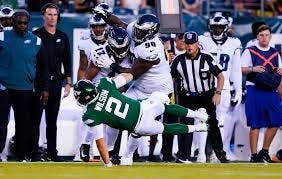Americans used to wear monocles, drive without power steering and play six NFL exhibition games a year.
In 1959 the Green Bay Packers played at Portland, at Bangor, at Winston-Salem and at Minneapolis in consecutive August and September weeks. The Cowboys once played on a field in Pendleton, Or., a day after the rodeo visited. It was a way to bring the game to the hinterlands and bring home a nice check. It also took nearly half the time that the 14-game regular season did.
So the current 3-game exhibition schedule is just an extension of such insanity, even though the stakes are higher.
Jets quarterback Zach Wilson (pictured), the No. 2 pick in the 2021 draft and supposedly the steward of the latest rebuild, scrambled in Philadelphia on Friday night and came up lame. It looked for all the world like an ACL tear, but instead it was just a meniscus. Wilson might miss two to four weeks.
Nick Harris, the center for the Browns, wasn’t as lucky. He was driven off the field in Jacksonville Friday night with a knee injury that will likely remove him from the 2022 season.
In Chicago Saturday, the Bears and Chiefs played a pantomime game on a cow pasture in Soldier Field, marred by Elton John concerts and soccer games.
This is where you reflexively mention that anybody can get hurt doing anything, and Wilson’s injury didn’t involve contact. It also didn’t involve brainpower, since he could have trotted out of bounds just as easily.
These games satisfy TV programming needs and are part of the regular-season ticket package. They are worthless and dangerous, and the Rams won a Super Bowl last year without risking any of their essential players on war games with real casualties.
Darryl Stingley was paralyzed by Jack Tatum in an exhibition game. Bubba Smith, a Hall of Fame defensive end if there ever was one, got tangled up with the guy carrying the first down marker and ruined his knee, also in an exhibition. They don’t actually use chains to measure anymore, but they still play exhibitions, which were euphemized brilliantly as “preseason games” by Pete Rozelle.
As a practical matter, there are players who owe their careers to exhibition-game opportunities. Cory Littleton was a special teams drone for the Rams, but he got enough reps to make the team, and then become a Pro Bowl linebacker. Austin Ekeler used the same tools to become the Chargers leading rusher and best backfield receiver.
And when the Rams returned to Los Angeles in 2016, they were greeted by a fourth-round draft pick named Rayne Dakota Prescott in their exhibition opener. Prescott threw brilliantly enough to become Tony Romo’s backup, and then became the Dallas starter before the season ended.
There is something to be said for playing in front of actual people. But all those players could leave the same impression during the joint workouts that are now in vogue. Team A will visit Team B for some up-close, full-speed hostility, and if both teams decide they need to work on third down efficiency, then they will do that as long as the coaches want. Logistically and humanely, the joint workout is a far better lab than the exhibition.
Jerry Kramer wrote “Instant Replay” after the 1967 regular season, the last in Green Bay for Vince Lombardi. It wasn’t “Ball Four” but it was highly revelatory. Kramer did not complain once about the six exhibitions. He did complaina about Lombardi’s excessive conditioning methods or his dehumanizing manner. What he really didn’t like was the money, or the necessity to grovel for it. He drew the line at a figure for the ‘67 season and got it. The number was $27,500, for a Pro Bowl guard who had been part of four NFL champions.
Back then, football was a part-time job. The typical player had to sell shoes or represent car dealers in the spring and summer. So the training camp was exactly that, a chance to get into shape. Today, of course, players are rich enough to hire their own trainers. They are expected to show up in July while in Septmber shape, and a vast majority do.
Plus, there are very few significant battles for roster spots. Those are mapped out during all those evaluation periods in the spring, at least for the veterans. If there’s a surprise rookie or undrafted free agent, he will not be turned away. There are 53 men on an active roster along with 13 on a practice squad.
Future generations will laugh and shake their heads over Grandpa’s goofiness when someone tries to tell them about the years of six exhibitions. But that’s not the weird part. The weird part is that the defending NFL champion had to begin the new season by playing in the College All-Star Game, at Soldier Field.
That’s right. If they did that today, Aaron Donald would be chasing Kenny Pickett around, and Matthew Stafford would have to dodge Aidan Hutchinson.
The game would draw 60,000 or so and drum up lots of money for charity, and occasionally it would make history. In 1963, Wisconsin’s Ron VanderKelen would bob and weave and lead the collegians to a 20-17 upset over the mighty Packers, a strong indication that the Packers wouldn’t be so mighty in 1963.
Seventeen regular season games reveal the truth more accurately, provided that everyone survives three exhibitions. For a league smart enough to turn its schedule announcement into a prime-time special and its draft into Woodstock, the exhibitions represent a brain cramp that, unnecessarily, makes the season questionable, if not doubtful.




McVay has it right. Sit ‘em until the games count.